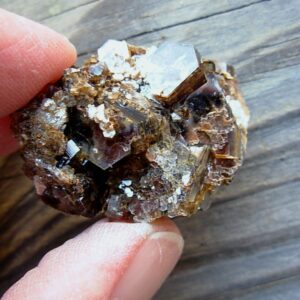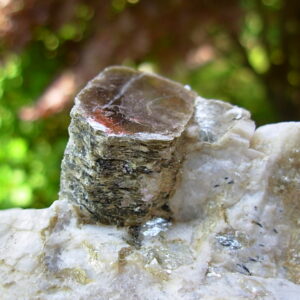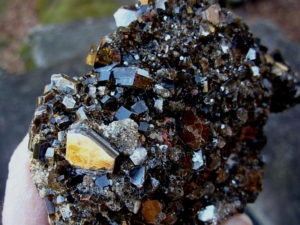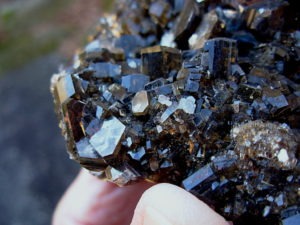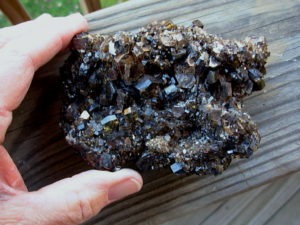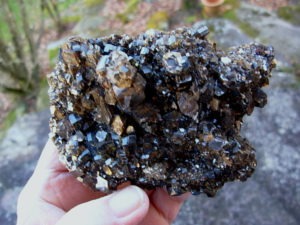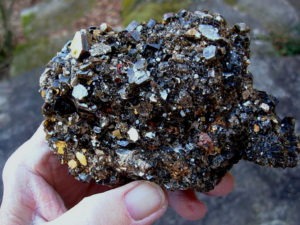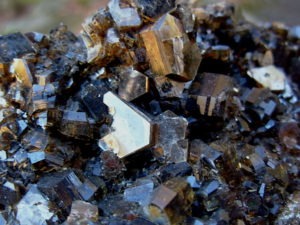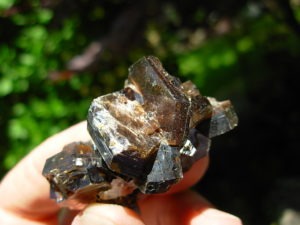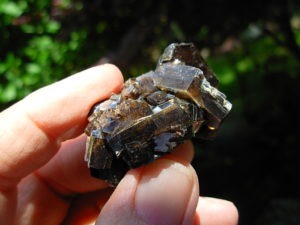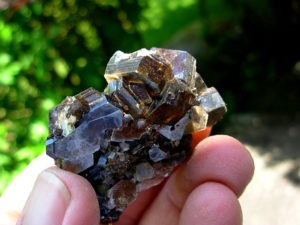Crystallized Mica
The Mica Group
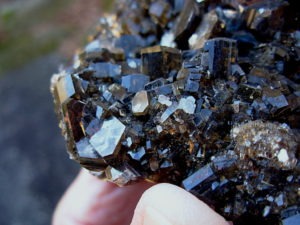 Large crystals of mica used for various applications are typically mined from granitic pegmatites. Collectible Mica specimens in the USA can be found in Spruce Pine, Franklin-Sylva and Shelby Hickory districts of North Carolina.
Large crystals of mica used for various applications are typically mined from granitic pegmatites. Collectible Mica specimens in the USA can be found in Spruce Pine, Franklin-Sylva and Shelby Hickory districts of North Carolina.
The mica group of sheet silicate (phyllosilicate) minerals includes several closely related materials having nearly perfect basal cleavage. Mica is normally found to be monoclinic (pseudo hexagonal), there also are hexagonal, orthorhombic, and triclinic forms generally referred to as polytopes. Among the principal rock-forming minerals, micas are found in all three major rock varieties; igneous, sedimentary, and metamorphic.
Of the 28 known species of the mica group, only 6 are common rock-forming minerals.
1) Muscovite, (Potassium Mica) the common light-colored mica. It was originally called “Muscovy glass” because it came from the Muscovy province of Russia
2) Biotite, (Magnesium Iron Mica) which is typically black or nearly so, is the most abundant. Biotite was named for Jean-Baptiste Biot, a 19th-century French physicist who studied the optical properties of micas.
3) Phlogopite, (Magnesium Mica) typically brown. Its name comes from the Greek word ‘phlogopos’ for fire like, which was chosen because of the reddish glow (color and luster) of some specimens
4) Paragonite, (Sodium Mica) which is macroscopically indistinguishable from muscovite, also is fairly common. From the Greek word ‘paragon’ “to mislead,” was so named because it was originally mistaken as talc.
5) Lepidolite, (Lithium Mica) generally pinkish to lilac in color, occurs in lithium-bearing pegmatites. From the Greek word 'lepidos' meaning “scale,” was based on the appearance of the mineral’s cleavage plates
6) Glauconite, (Iron Potassium Phyllosilicate Mica) a green species that does not have the same general macroscopic characteristics as the other micas, occurs sporadically in many marine sedimentary sequences. All of these micas except Glauconite exhibit easily observable perfect cleavage into flexible sheets. Glauconite, which most often occurs as pellet like grains, has no apparent cleavage. Although typically green, was named for the Greek word for blue ‘glaucos ‘
There is a rare crystallized Mica that can be found near Shelby, Cleveland County, North Carolina. It is a tabular 6 sided Phlogopite Mica. It has sharp, well defined mica crystals and most specimens have a red-brown clay in the crevices between the crystals. The mica crystals are brown, platy hexagonal form, with secondary edge faces. When back lit or viewed in the correct sunlight angle the crystals show translucent solidification of the mica plates. The individual sheets or layers of mica actually crystallize and form single solid crystals. These amazing solid crystals are found in clusters. These rare North Carolina crystallized Mica specimens are highly sought after!
Item # 24MIC0317S9900
505g Mica Crystals from Mitchell County, North Carolina

This specimen has multiple tabular 6 sided Phlogopite Mica crystals. Large mica crystal clusters are quite rare. The mica crystals are brown, platy hexagonal form, with secondary edge faces. When back lit or viewed in the correct sunlight angle the crystals show translucent solidification of the mica plates.
Specimen weighs 17.8oz or 1.1 lb (505g) and measures 4.9 x 4.4 x 2.1" (12.4 x 11.1 x 5.5cm)
Item # 18MIC06161512
Crystallized Mica from Shelby, Cleveland County, N.C.
$49.00

This is a rare and special mica specimen from near Shelby in Cleveland County, North Carolina. These unique crystals have a translucent amber color when viewed in correct sunlight angle or when back lit.
Specimen weighs 1.48oz (42g) and measures 1.79 x 1.44 x 1.1" (45 x 37 x 28mm)


